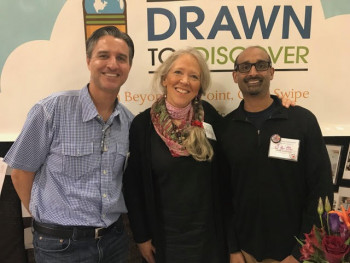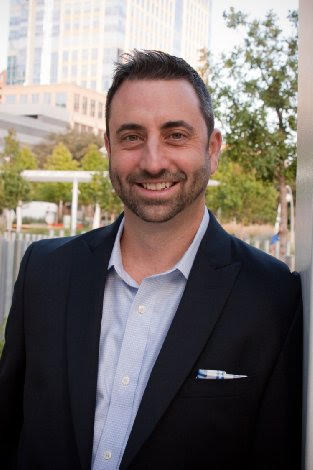Three DePauw friends add up to an online educational startup
One is a marketer. Another, a real estate investor, with some website design on the side. The third is an education expert.
For more than 28 years and across thousands of miles, their connection has been a friendship forged at DePauw. But now they’ve found a new way of connecting – a professional collaboration that taps each alum’s expertise.
The modern chapter of their story starts with Brian Goodman ’94, who was on vacation a few years ago with his family in Michigan. There he met Wendy Anderson Halperin, a children’s book illustrator who – inspired by an NPR story – had created an enrichment program predicated on the notion that children’s fine motor skills, including their pencil grip, affect their reading comprehension, vocabulary development and other intellectual capabilities.
It so happens that Goodman, who lives near Chicago and has worked in marketing and advertising since graduating from DePauw, had advised Halperin’s filmmaker husband on how to secure funding for a documentary. To thank him, Halperin offered her educational program – which she had been teaching to children in nearby schools and to teachers via seminars and videos – to Goodman, who had been looking for something to help his older son, who has special needs, progress academically.
 Goodman, so impressed with Halperin’s work that he claims she is “channeling DaVinci,” introduced the program to his sons, now 13 and 8, and they loved it. That sparked an idea with Dad: What if he arranged to professionally videotape Halperin’s lessons and made them easily accessible by online subscription?
Goodman, so impressed with Halperin’s work that he claims she is “channeling DaVinci,” introduced the program to his sons, now 13 and 8, and they loved it. That sparked an idea with Dad: What if he arranged to professionally videotape Halperin’s lessons and made them easily accessible by online subscription?
He researched other literacy programs and the possible demand for such a product. Then he called Samir Patel ’95, whom he met on the day in 1990 when they were moving into Humbert Hall at DePauw. Patel, who runs a San Diego real estate company and creates websites, was intrigued.
“I flew out to Chicago and we went to Michigan to watch Wendy work in the classroom,” Patel says. The old friends pitched Halperin on the idea of an online business they dubbed Drawn to Discover.
“She got super excited about it right away,” Goodman says. “…We jumped into it; she let me take over her studio in her home. We bought new 4K cameras and studio lights and she let me put a contraption over the top of her desk and build it all up for her so we can mike her up correctly. And she just cranks out video after video after video. As a startup, the biggest thing that you worry about is content, and content was easy. It was just about her. She’s a machine.”
The serendipity was facilitated by DePauw.– David Barrett ’94
Patel focused on creating the website, https://drawntodiscover.com/. The team soft-launched it in summer 2017, tweaked the design to make it easier for children to use and fully launched the platform last January. They are marketing via keyword searches on the web, on social media and by identifying niche markets, such as mom bloggers and home schoolers. They’re also issuing news releases and connecting with education experts and advocates.
The team has conducted some research to verify Halperin’s findings, especially in Michigan schools where Halperin taught the program in person. But Goodman says he knew more rigorous research was needed, so he sought advice from another friend from college – David Barrett ’94, whom he and Patel had met when all three pledged Phi Delta Theta.
“As I talked with him,” Barrett says, “I became very excited about what they were doing and I said, ‘I want in and I want to help in some way and be part of this’ because I think it’s something that is needed.”
 Barrett works in educational research and program evaluation at the Meadows Center for Preventing Educational Risk, part of the University of Texas at Austin. He says the research in the Michigan schools found that students who had gone through the program used more words and more descriptive words, had fewer grammatical errors and had better handwriting than children who had not.
Barrett works in educational research and program evaluation at the Meadows Center for Preventing Educational Risk, part of the University of Texas at Austin. He says the research in the Michigan schools found that students who had gone through the program used more words and more descriptive words, had fewer grammatical errors and had better handwriting than children who had not.
With Drawn to Discover, his job is to oversee the research function, including working with an Indiana University professor who studies the effects of handwriting on cognitive development.
In addition, Goodman and Barrett created a podcast called “What is Creativity” to educate parents about their children’s fine muscle control. Still another DePauw connection was among the first guests: David Hersh ’94, who co-founded Jive Software in the early 2000s and took it public in 2011.
“Too often, society looks at creativity as something that only an artist, writer, actor, musician or someone with those types of natural gifts has,” Goodman says. “But it has always been my belief that all people are creative and people from many different employment and success backgrounds are full of creativity. So our podcast seeks out people from various types of industries to discuss creativity.”
People numbering “in the low single thousands” have subscribed to Drawn to Discover. “Once we get over 10,000 subscribers, we know we have a sustainable business,” Goodman says. He is confident enough that he quit his job and is devoting full time to Drawn to Discover; Patel says he’d like to do the same.
Barrett, meanwhile, says he’s been thinking about the coincidences that have come into play to create the potential for Drawn to Discover to succeed: Goodman’s need for a program for his son. His meeting Halperin. The three men’s career choices. And their deep DePauw connection.
“The serendipity,” he says, “was facilitated by DePauw.”
Browse other stories
-
Athletics
-
Women's Swimming & Diving - DePauw Women Recognized as a Spring 2025 Scholar All-America Team; Three Tigers Recognized
-
Men's Swimming & Diving - DePauw Men Recognized as a Spring 2025 Scholar All-America Team
-
Men's Basketball - Tigers Earn NABC Team Academic Excellence Award; Four Student-Athletes Named to Honor Court
More Athletics
-
-
News
-
National grant supports DePauw’s commitment to civil dialogue
-
Outstanding scholars named to Spring 2025 Dean's List
-
Alumni News Roundup - June 6, 2025
More News
-
-
People & Profiles
-
11 alums make list of influential Hoosiers
-
DePauw welcomes Dr. Manal Shalaby as Fulbright Scholar-in-Residence
-
DePauw Names New Vice President for Communications and Strategy and Chief of Staff
More People & Profiles
-
-
Have a story idea?
Whether we are writing about the intellectual challenge of our classrooms, a campus life that builds leadership, incredible faculty achievements or the seemingly endless stories of alumni success, we think DePauw has some fun stories to tell.
-
Communications & Marketing
101 E. Seminary St.
Greencastle, IN, 46135-0037
communicate@depauw.eduNews and Media
-
News media: For help with a story, contact:
Bob Weaver, Senior Director of Communications.
bobweaver@depauw.edu.